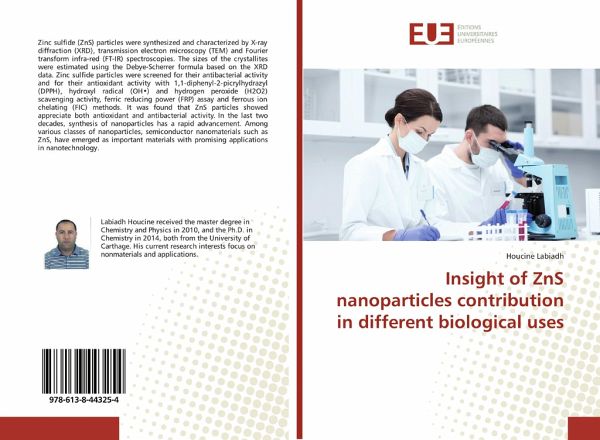
Insight of ZnS nanoparticles contribution in different biological uses
Versandkostenfrei!
Versandfertig in 6-10 Tagen
26,99 €
inkl. MwSt.

PAYBACK Punkte
13 °P sammeln!
Zinc sulfide (ZnS) particles were synthesized and characterized by X-ray diffraction (XRD), transmission electron microscopy (TEM) and Fourier transform infra-red (FT-IR) spectroscopies. The sizes of the crystallites were estimated using the Debye-Scherrer formula based on the XRD data. Zinc sulfide particles were screened for their antibacterial activity and for their antioxidant activity with 1,1-diphenyl-2-picrylhydrazyl (DPPH), hydroxyl radical (OH-) and hydrogen peroxide (H2O2) scavenging activity, ferric reducing power (FRP) assay and ferrous ion chelating (FIC) methods. It was found tha...
Zinc sulfide (ZnS) particles were synthesized and characterized by X-ray diffraction (XRD), transmission electron microscopy (TEM) and Fourier transform infra-red (FT-IR) spectroscopies. The sizes of the crystallites were estimated using the Debye-Scherrer formula based on the XRD data. Zinc sulfide particles were screened for their antibacterial activity and for their antioxidant activity with 1,1-diphenyl-2-picrylhydrazyl (DPPH), hydroxyl radical (OH-) and hydrogen peroxide (H2O2) scavenging activity, ferric reducing power (FRP) assay and ferrous ion chelating (FIC) methods. It was found that ZnS particles showed appreciate both antioxidant and antibacterial activity. In the last two decades, synthesis of nanoparticles has a rapid advancement. Among various classes of nanoparticles, semiconductor nanomaterials such as ZnS, have emerged as important materials with promising applications in nanotechnology.












